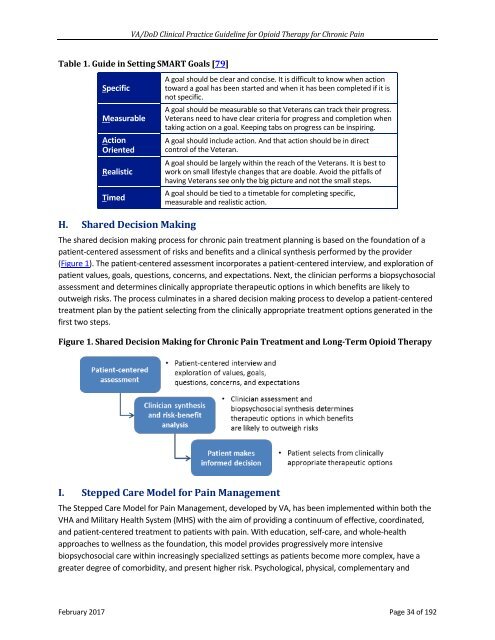VA/DoD CLINICAL PRACTICE GUIDELINE FOR OPIOID THERAPY FOR CHRONIC PAIN
2lfFhbO
2lfFhbO
You also want an ePaper? Increase the reach of your titles
YUMPU automatically turns print PDFs into web optimized ePapers that Google loves.
<strong>VA</strong>/<strong>DoD</strong> Clinical Practice Guideline for Opioid Therapy for Chronic Pain<br />
Table 1. Guide in Setting SMART Goals [79]<br />
Specific<br />
Measurable<br />
Action<br />
Oriented<br />
Realistic<br />
Timed<br />
A goal should be clear and concise. It is difficult to know when action<br />
toward a goal has been started and when it has been completed if it is<br />
not specific.<br />
A goal should be measurable so that Veterans can track their progress.<br />
Veterans need to have clear criteria for progress and completion when<br />
taking action on a goal. Keeping tabs on progress can be inspiring.<br />
A goal should include action. And that action should be in direct<br />
control of the Veteran.<br />
A goal should be largely within the reach of the Veterans. It is best to<br />
work on small lifestyle changes that are doable. Avoid the pitfalls of<br />
having Veterans see only the big picture and not the small steps.<br />
A goal should be tied to a timetable for completing specific,<br />
measurable and realistic action.<br />
H. Shared Decision Making<br />
The shared decision making process for chronic pain treatment planning is based on the foundation of a<br />
patient-centered assessment of risks and benefits and a clinical synthesis performed by the provider<br />
(Figure 1). The patient-centered assessment incorporates a patient-centered interview, and exploration of<br />
patient values, goals, questions, concerns, and expectations. Next, the clinician performs a biopsychosocial<br />
assessment and determines clinically appropriate therapeutic options in which benefits are likely to<br />
outweigh risks. The process culminates in a shared decision making process to develop a patient-centered<br />
treatment plan by the patient selecting from the clinically appropriate treatment options generated in the<br />
first two steps.<br />
Figure 1. Shared Decision Making for Chronic Pain Treatment and Long-Term Opioid Therapy<br />
I. Stepped Care Model for Pain Management<br />
The Stepped Care Model for Pain Management, developed by <strong>VA</strong>, has been implemented within both the<br />
VHA and Military Health System (MHS) with the aim of providing a continuum of effective, coordinated,<br />
and patient-centered treatment to patients with pain. With education, self-care, and whole-health<br />
approaches to wellness as the foundation, this model provides progressively more intensive<br />
biopsychosocial care within increasingly specialized settings as patients become more complex, have a<br />
greater degree of comorbidity, and present higher risk. Psychological, physical, complementary and<br />
February 2017 Page 34 of 192


